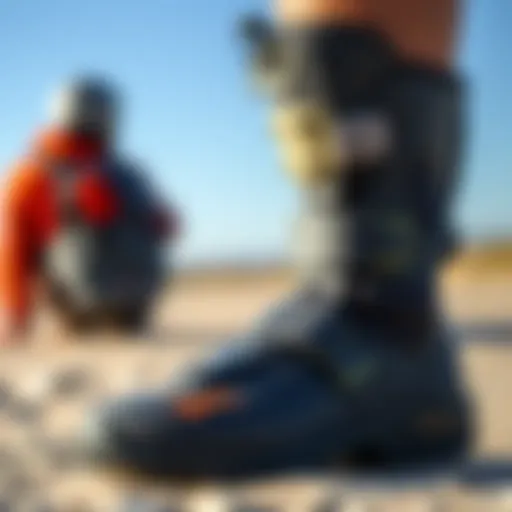Exploring the Dynamics of Air Foil Surfing Techniques


Intro
Air foil surfing has rapidly emerged as an electrifying offshoot of traditional surfing, captivating enthusiasts with its unique blend of mechanics and thrilling experiences. Imagine gliding seamlessly above the water's surface, propelled by the lift generated from an air foil beneath your board. This exhilarating sport challenges the norms of ocean riding, offering both novices and seasoned surfers something fresh and invigorating.
This guide aims to walk readers through essential aspects of air foil surfing—from foundational techniques that beginners can grasp to advanced maneuvers for those looking to refine their skills. Dipping into the specifics of gear and equipment will help clarify what is necessary for a successful ride. Furthermore, this article touches on global hotspots where surfers can experience this dynamic sport in its element. With a blend of insights, safety guidelines, and expert tips, the aim is to enrich everyone's understanding of what makes air foil surfing a unique, captivating water sport.
We will delve into techniques, equipment reviews, and more to illuminate the vibrant world of air foil surfing.
Techniques
Beginner Techniques
For those just embarking on their air foil surfing journey, mastering the basics is essential.
- Understanding Balance: At the heart of air foil surfing lies the importance of balance. Position yourself with your feet shoulder-width apart. A slight bend in the knees can enhance stability. This foundational stance is your ticket to staying upright as you start feeling the lift from the foil.
- Weight Distribution: Changing your body’s weight alters how the foil interacts with the water. Leaning slightly back can help you lift out of the water, while shifting your weight forward brings the board back down. Finding this balance is akin to walking a tightrope.
- Starting with a Kite: If you're new to kiteboarding as well, practicing with a kite can greatly assist in developing your timing and control over the board. Start by simply hovering and riding before moving onto more advanced techniques.
Advanced Freestyle Maneuvers
For those who’ve gotten the hang of the basics, there’s a world of creativity to explore. Here are some advanced moves that can elevate your air foil surfing experience:
- The Dip: A daring dip where the foil cuts through the water, allowing for a momentary weightlessness before launching into aerial tricks. This requires precision; too much pressure, and you’ll find yourself submerged.
- The Flip: Executing a flip involves timing and control. Using the natural lift of the foil, as you prepare for the move, shifting your weight back will help you initiate the maneuver smoothly. It's all in the wrist, as controlling your board will dictate how beautifully you land.
- Transitions: Whether you're switching directions or moving between different setups, mastering transitions can make your ride more dynamic. Keeping your eyes focused on where you want to go while adjusting your stance is key.
"Air foil surfing pushes the limits of what is possible on water, combining balance and technique to create a mesmerizing art of grace and thrill."
With these techniques listed above, both upcoming enthusiasts and seasoned professionals can advance their skills, every wave a new opportunity to learn and improve.
\n
Gear Reviews
Latest Kiteboarding Equipment
Choosing the right gear can make a world of difference in air foil surfing. Some notable equipment options include:
- Foil Boards: Opt for a lighter board with good buoyancy. These boards should be stable enough to ride comfortably but responsive to your movements.
- Kites: Modern kites have improved significantly in terms of stability and lift. Brands like Ozone and Cabrinha offer options catering to different skill levels and wind conditions.
- Wetsuits: Depending on your location, a good wetsuit isn't just about warmth; it also offers protection from falls, making it easier to get back up after miscalculating that dip.
Essential Accessories for Kiteboarders
No surfer is complete without their accessories, the unsung heroes of every ride:
- Helmets: Safety first! A good helmet protects your noggin during daring maneuvers.
- Impact Vests: Helpful for absorbing shock during falls, ensuring your ride doesn’t end in a sore back.
- Board Leashes: These keep your board attached to you, saving the hassle of swimming after it!
As air foil surfing continues to gain popularity, continuous advancements in gear will only enhance the experience. It's important to stay informed and adapt to new technologies to keep the sport thrilling and safe.
These insights aim to provide a starting place for kiteboarders, instructors and anyone keen to dive into this emerging water sport. The sky—or rather, the surf—is the limit!
Prolusion to Air Foil Surfing
Understanding air foil surfing is like peeling an onion—it has many layers, each revealing something more intriguing. This sport combines elements of traditional surfing and innovative hydrodynamics, creating an experience that’s both exhilarating and challenging. For those who seek a unique ride above the waves, air foil surfing offers the allure of fast speeds and an almost dream-like gliding motion.
As we dive into the intricacies of this sport, it’s crucial to pin down its definition and explore its historical context. Awareness of its evolution not only paints a picture of where it stands today but also highlights the benefits and considerations that make it a compelling pursuit for kiteboarders and surf enthusiasts alike. What once was merely a concept has transformed into a thriving community, drawing the attention of instructors, marketers, and travel agents—anyone with a finger on the pulse of watersport trends.
Air foil surfing offers distinct advantages that set it apart from more conventional forms of surfing—a notable one being its ability to catch smaller, less powerful waves. This means the pursuit opens up more opportunities for enjoyment across various conditions and locations. Additionally, it’s often viewed as borrowing from the kiteboarding world, thus advocating for a synergy of techniques that invite both collaboration and competition.
In summary, this section lays the foundation for understanding air foil surfing. By grasping its core principles and contextual evolution, readers can better appreciate the innovations and unique experiences this sport brings to the global surfing landscape.
The Mechanics of Air Foiling
Understanding the mechanics of air foiling serves as the foundation for experiencing this thrilling water sport effectively. It’s not just about balancing on the board; it encompasses the intricate relationship between the foil’s design, hydrodynamics, and rider mechanics. Each of these components holds great significance when it comes to performance and safety.
When diving into air foiling, one must grasp elemental principles. The design of the foil, the way it interacts with water, and how a rider adjusts their body contribute greatly to the experience on the water. Recognizing these mechanical aspects helps riders maximize their enjoyment and proficiency, offering both excitement and challenge in a harmonious balance.
Basic Principles of Foil Design


Foil design isn’t something to be taken lightly. At its core, a foil consists of a mast, fuselage, and wings. Each part must work seamlessly together. Usually, riders choose wings with specific shapes that can yield optimal lift and drag characteristics. A high-aspect wing, for instance, is typically better for speed, while a low-aspect wing is renowned for stability and maneuverability.
Understanding how to select the right foil boils down to knowing one’s own riding style and environmental conditions. This can lead to thrilling rides or frustrating experiences. Choosing the right foil depends greatly on whether you aim for carving through waves or skimming across flat water.
Hydrodynamics and Lift Generation
Hydrodynamics is a critical component that many might overlook, yet it’s everything in air foil surfing. The way water flows around the wing generates lift, much like how airplane wings function in the air. A rider's ability to maintain speed directly influences the amount of lift produced by the foil.
The key here is that lift must always overcome gravitational forces for the surfer to rise above the water. As surfers pump their boards and maintain an optimum speed, they experience that exhilarating sensation of flight. This dance with water's dynamics highlights how crucial it is to understand both speed and technique when engaging with air foiling.
Riding Mechanics
When it comes to riding mechanics, two primary factors determine success—body positioning and weight distribution. Let’s break these down individually.
Body Positioning
Body positioning plays an integral role in air foiling. It’s not merely standing upright on the board; it requires constant adjustment based on the foil’s angle in relation to the water’s surface. The key characteristic of good body positioning involves a slightly forward-leaning posture that helps shift the center of gravity forward, ultimately enhancing lift and stability.
This unique feature of body positioning aids in controlling speed and responsiveness to the water's surface. Riding with a more engaged stance provides the rider better control over the foil, leading to a more enjoyable ride. Adopting this stance helps even novice riders feel like seasoned professionals.
Weight Distribution
Weight distribution is another fundamental element. Effective weight distribution enhances the ability to ride smoothly while minimizing chances of crashing into the water. The key characteristic of proper weight distribution involves placing weight primarily over the front foot during takeoff and gradually shifting weight to the back foot during glides. This gradual shift fosters better control and maneuverability.
A unique feature of advanced weight distribution techniques allows riders to adapt their stance based on wind and wave conditions. However, getting this balance wrong can lead to problems. If too much weight is placed too far back, the foil may breach the water, causing a nasty fall.
In summary, mastering the mechanics of air foiling—especially body positioning and weight distribution—is vital for both safety and performance. Mixing these elements with environmental awareness elevates the air foiling experience, making it more dynamic and enjoyable. Riding can become an art form, fluid and instinctive, once these mechanics are understood and practiced.
Essential Gear for Air Foil Surfing
When diving into air foil surfing, having the right gear isn't just an added bonus; it's a necessity that can greatly affect both performance and safety. The dynamics at play between the board, the foil, and the rider can transform an average surfing experience into something extraordinary. In this section, we will explore essential gear needed for a successful foray into air foiling, emphasizing various components, benefits, and crucial considerations.
Surfboards and Foils Overview
Starting with the surfboard itself, it is tailored specifically for air foil surfing. These boards are lighter and often wider than traditional surfboards to accommodate the unique lift and balance a foil requires. Typically, the boards come with deep channels that help manage water flow, improving stability and responsiveness.
The foil includes a mast, wings, and a fuselage, generally designed for optimal hydrodynamic performance. What's critical here is the proper pairing of board and foil. A mismatch can lead to a lack of control, making it essentially impossible to maintain the ride. Think about it like trying to fit a square peg into a round hole; it just won’t work, no matter how hard you try.
It’s also important to consider that the material of choice for both the board and the foil plays a huge role in your overall experience. High-density foams or carbon fiber not only add strength but possess lightweight properties that can lead to improved performance.
Specific Equipment Considerations
Wing Types
Wing types are a critical aspect of air foiling. The design, surface area, and shape of the wing dictate how it interacts with the water and air above. For instance, larger wings are often seen as more stable, especially for beginners looking to find their footing. These wings generate a more significant lift at lower speeds, allowing for a smoother experience. On the flipside, smaller wings are meant for speed and agility but require a more experienced rider.
A unique feature of high-aspect wings is their elongated shape, which increases efficiency and reduces drag. However, they make the equipment less stable, perhaps complicating matters for newcomers to the sport. This means that a rider needs to carefully evaluate their skill level and intended use before making a purchase.
- Key Characteristics of Wing Types:
- Advantages and Disadvantages:
- Surface area dictates lift.
- Shape influences drag and stability.
- Larger wings: more stable but less agile.
- Smaller wings: agile but require skill.
Control Systems
Control systems significantly contribute to how a rider manages their foil while surfing. These systems often comprise a variety of components, such as foot straps or pads that allow for enhanced control and foot placement. An effective control system permits a rider to engage and disengage with the foil, navigating waves effortlessly.
You might find that some systems are more prone to wear and tear, especially under aggressive conditions. Thus, investing in a durable control setup should be on the rider's radar. Some of the more popular options utilize adjustable straps to ensure that even a novice can find their comfort level.
- Key Characteristics of Control Systems:
- Unique Features:
- Adjustable foot placement increases comfort.
- Durable materials resist wear.
- Ant-slip designs prevent slippage during harsh rides.


Safety Equipment and Obligations
Though we often focus on performance when discussing equipment, it’s crucial to also consider safety gear. Helmets and impact vests are paramount in safeguarding against falls and unexpected impacts. Additionally, personal flotation devices can save lives, especially in challenging surf conditions.
In terms of obligations, awareness of local regulations regarding air foil surfing cannot be overstated. Many regions have rules regarding where and when you can surf, necessitating research before you hit the water. Ignoring these considerations not only places the rider at risk but can also disrupt the community.
In summary, choosing the right gear and understanding its elements cannot be overstated in air foil surfing. Each piece of equipment—from the surfboard and the foil to safety measures—plays a critical role in enhancing both safety and overall experience. Make informed choices and gear up properly, and you'll find your dives into air foil surfing rewarding.
Techniques in Air Foil Surfing
In the realm of air foil surfing, mastering various techniques is not just an enhancement but a necessity. The art lies in the interplay between the board and the foil, requiring a precise blend of body positioning, weight distribution, and environmental awareness. Techniques in air foiling bring about higher performance, better control, and an overall more enjoyable experience. Whether you're merely floating across a calm sea or carving through powerful swells, understanding these skills can significantly elevate your ride.
Floating and Gliding Techniques
Floating and gliding are fundamental to air foil surfing, serving as the building blocks for new riders. These techniques revolve around maintaining a smooth and steady ride while maximizing lift. Proper body positioning is crucial here. The rider should lean slightly forward to help the foil engage with the water, focusing on keeping their center of gravity low. It’s about finding that sweet spot where you feel the foil start to lift and glide above the surface.
One key factor to consider is speed—the faster you go, the more lift you’ll generate, but too much speed can lead to instability. Riders often practice this technique in lighter winds and smaller waves to build confidence and experience. The prevailing guideline is, if you can float effortlessly, you’ll be well on your way to mastering the more complex maneuvers.
Turning and Maneuvering
Like a fencer with a rapier, a foil surfer must have quick reflexes and precision. Turning and maneuvering techniques are essential for navigating waves and adjusting to changing conditions. To initiate a turn, the rider shifts their weight subtly—leaning in the direction they want to go while maintaining balance on the foil.
During turning, it’s vital to feel the board’s response. A well-timed shift in weight will allow the surfer to carve smoothly, like a knife through butter. Riders can experiment with different turning radii based on their comfort level and the conditions they face. In strong winds, smaller, sharper turns may be effective, while in lighter winds, a more gradual arc will keep momentum and control intact.
Adapting to Conditions
Adapting to conditions is where seasoned riders set themselves apart. Two major factors that influence conditions are wind patterns and wave heights.
Wind Patterns
Wind patterns can make or break an air foil surfing experience. Understanding local wind behavior is essential for selecting the best times and locations to surf. Typically, consistent, steady winds provide the most reliable lift and control for riding.
A key characteristic of favorable wind conditions is direction. Offshore winds, which blow from land to sea, offer excellent lift. They can create cleaner waves without the chop that onshore winds may bring. However, it is important to keep an eye out for changing patterns, as strong gusts can easily lead to a loss of control—not a situation anyone wants.
"In air foil surfing, following the wind is as crucial as knowing the waves. A misjudged wind can send you spiraling rather than soaring."
Wave Heights
Wave heights also play a crucial role in air foil surfing. Ideal wave conditions typically involve medium-sized waves that allow for both lift and stability. A rider needs to gauge their skill level against the wave size; larger waves may bring increased thrills but can also present challenges for balance and control.
A unique aspect of wave heights is their variability. While some beaches present consistent, rolling swells, others may experience sudden drops or steep faces. Riders are encouraged to familiarize themselves with local surf reports and use tools like buoys or forecasting websites to assess wave conditions. Having this knowledge helps ensure a safer and more enjoyable session.
Comparative Analysis with Traditional Surfing
In the ever-evolving landscape of water sports, air foil surfing presents a fresh take compared to its more conventional counterpart, traditional surfing. Understanding the distinctions between these two forms of surfing helps enthusiasts appreciate the intricacies and innovations that characterize air foiling. This comparative analysis is not merely academic; it informs decisions made by potential practitioners regarding gear selection, skill development, and environmental considerations.
Performance and Speed
Performance metrics vary significantly when comparing air foil surfing to traditional surfing. The underlying mechanics of foiling lift a surfer above the water’s surface, almost gliding over it with reduced drag. This lift contributes to greater speed capabilities in a broader range of conditions. In fact, while traditional surfers might struggle in smaller waves, foilers can harness lighter winds and smaller swells, unlocking performance opportunities in conditions not typically favorable for standard surfing.
- Advantages of Speed in Air Foil Surfing:
- Capable of maintaining speed in low wave conditions.
- Enhanced ability to ride and connect swells due to reduced resistance.
- Opportunities for high-speed maneuvers that traditional surfing may not capitalize on.
Overall, the ability to harness speed efficiently makes foil surfing attractive for those looking to explore different scenery and environments after the waves recede.
Skill Requirements
Transitioning to air foil surfing requires a different skill set compared to traditional surfing, although some foundational skills overlap. For instance, balance is crucial in both disciplines, but the nuances are varied. Foil surfers need to master the art of weight distribution meticulously to maintain the stable lift without coming crashing down.
- Key Skill Distinctions:
- Balance and Core Strength: Core stability is paramount in air foiling to manage the tilt of the board.
- Reaction to Conditions: Air foil surfers must learn to read both wind patterns and water currents more acutely than traditional surfers.
- Maneuvering Techniques: There’s a greater emphasis on utilizing foot pressure to control flight, steering with subtle movements.
Environmental Impact


The environmental considerations between air foil surfing and traditional surfing raise intriguing points of discussion. While both sports share a love for harnessing nature, their ecological footprints differ in subtle yet significant ways. Air foil surfing features a lighter, simpler setup, reducing the need for expansive boards and additional gear generally associated with conventional surfers.
- Factors of Environmental Impact:
- Minimal Gear: Foils and boards often use less materials than regular surfboards, cutting down on production waste.
- Altered Wave Interaction: While traditional surfing might contribute to wave erosion, the surfboard lift of foiling may disturb less surrounding marine life due to its reduced water surface interaction.
- Local Ecosystem Effects: With the ability to operate in more varied conditions, foilers can explore less frequented spots, potentially mitigating over-crowding at established surf breaks.
To encapsulate, air foil surfing provides an alternative that might lead to a more sustainable practice, should the sport continue to grow within ecologically conscious frameworks.
"As air foil surfing gains momentum, it also presents a chance to redefine what it means to surf responsibly in natural ecosystems."
The Future of Air Foil Surfing
As air foil surfing continues to carve its niche in the diverse world of watersports, the future of this activity is painted with potential innovations and a vibrant community spirit. Understanding what lies ahead is crucial for enthusiasts, instructors, and marketers, as it can shape their experiences and businesses. With advancements in technology and a growing community, we explore how air foil surfing is set to evolve in the coming years.
Innovations in Equipment
One of the most exciting aspects of air foil surfing is the rapid progression in equipment design. Manufacturers are continuously researching and developing better gear, which enhances performance and safety. Some notable innovations include:
- Advanced Materials: The use of lighter and more durable materials can tremendously impact the overall experience. For instance, foils crafted from carbon fiber are becoming more common, allowing for increased stiffness without weighing too much.
- Variable Foil Designs: Modularity in foil designs lets riders customize their experiences. Having wings that are interchangeable means surfers can adapt to different conditions, optimizing lift and maneuverability on demand.
- Smart Technology Integration: Imagine equipment that comes equipped with sensors. These devices can track performance data in real-time, offering insights into technique and suggesting improvements. This tech-savvy approach can help novices refine their skills quickly.
- Inflatable Foils: New inflatable foil designs are emerging. Not only do they offer portability but they can also reduce the risk of injury upon impact. This innovation in design is particularly enticing for those who travel frequently.
Incorporating these advancements might not only attract more practitioners but also improve the safety and ease of learning.
Emerging Trends in the Community
The community surrounding air foil surfing is as dynamic as the sport itself. As interest grows, several trends make waves:
- Collective Events: More enthusiasts are joining organized sessions, creating a synergetic atmosphere where skills can be shared and developed collectively. These gatherings often serve as informal workshops, making them rich with learning opportunities.
- Online Platforms and Social Media: Platforms like Reddit and Facebook are fostering discussions and communities around air foil surfing. You can find tips, tricks, and reviews shared among fellow surfers readily. This digital landscape is planting seeds for collaborations and innovations.
- Sustainability Focus: As awareness about environmental impacts grows, there's a distinct shift in the community towards sustainable practices. Discussions around eco-friendly materials and methods for minimizing environmental footprints while foiling are becoming prominent.
- Inclusive Initiatives: New programs aimed at inclusivity are emerging, encouraging participation among different demographics. This trend seeks to break down barriers and invite more individuals to enjoy these thrilling watersports.
As the community grows and diversifies, it stands to enhance the future of air foil surfing significantly, influencing societal trends beyond mere sport.
"Innovation and community are breads that sustain the new world of surf foiling; they are the waves we ride into the future."
Global Spots for Air Foil Surfing
The global landscape for air foil surfing is as varied and dynamic as the sport itself. Identifying premier locations is vital for enthusiasts seeking not just thrilling experiences, but also favorable conditions that cater to different skill levels. The right spot can enhance performance, provide safety, and even foster a sense of community among surfers. This section discusses notable destinations and key local conditions necessary for a successful scurfing experience.
Top Destinations Around the World
- Maui, Hawaii
Renowned for its consistent winds and stunning scenery, Maui has become a mecca for foil surfers across the globe. The famous Ho‘okipa Beach provides smooth waters conducive to short or long-distance rides. Surfers can find both beginner-friendly spots and challenging conditions for the experts. The local surf culture is rich, and there are ample rental services for gear. - Cabo San Lucas, Mexico
With its tranquil bays and robust winds, Cabo is ideal for foil surfing with incredible views of the rugged coastline. The waters are often warm, making it a fantastic winter getaway. Popular spots include La Ventana, known for steady conditions and vibrant local community, where both novices and advanced surfers can thrive. - Lake Michigan, USA
An unexpected destination, Lake Michigan offers unique foil surfing experiences. Areas like the Indiana Dunes provide flat-water sessions on calm days, great for beginners. The lake can also pack a punch during storms, attracting seasoned surfers willing to take on its waves. - The Gold Coast, Australia
This spot is famous not just for surfing, but for air foil surfing too. The Gold Coast boasts beaches that cater to surfers of all levels. Each season presents different opportunities — with winter months ideal for creating memorable gliding sessions. The local community is friendly, and you'll find many shops offering lessons and rentals.
Local Conditions and Considerations
Understanding local conditions is paramount for anyone interested in air foil surfing.
- Wind Patterns: Each destination features its own wind patterns, which can significantly impact the experience. For instance, Maui sees trade winds that create perfect lift, while the Gold Coast has fluctuating conditions that can challenge even experienced surfers.
- Wave Heights: The variance in wave heights is crucial. Lake Michigan's milder waves suit beginners, while locations like Maui can offer both gentle swells and more challenging surf when needed.
- Tides and Currents: It’s essential to familiarize oneself with tide schedules and current flows in each destination. For example, Cabo often has strong currents that can be tricky for newcomers but exhilarating for the more experienced.
- Weather: Weather can change drastically, impacting visibility and comfort. Surfing in places like Australia’s Gold Coast may require attention to seasonal changes to get the best experience possible.
- Safety Considerations: Every spot has its specific safety arrangements like lifeguards and emergency services. Always be wary of local guidelines and signage to ensure a safe and enjoyable experience.
"Finding the right location is half the battle. Coupling good conditions with quality gear makes for an unforgettable ride."
These variables come together to weave a rich tapestry of experiences, each location offering its own unique flavor to air foil surfing. Placing an emphasis on properly understanding and articulating the dynamics of chosen spots can lead to more rewarding sessions on the water.
Closure and Reflective Insights
In wrapping up a thorough examination of air foil surfing, it's vital to pause and consider the broader implications and lessons this sport conveys. The intricacies of air foiling—its mechanics, techniques, and equipment—offer a unique perspective on what traditional surfing embodies and the transformative nature of water sports in general. Through this investigation, we navigate not just the technicalities, but also the deeper connections individuals forge with the ocean and the ever-evolving landscape of surfing culture.
Revisiting Core Principles
As we revisit the core principles outlined throughout this article, it's clear that air foil surfing is built on a firm foundation of physics and artistry.
- Lift and Balance: The essence lies in understanding how lift is created and maintained through the foil design. This dynamic relationship between water and air demonstrates the sport’s reliance on both ingenuity and nature.
- Adaptability: Riders’ ability to adapt based on changing conditions showcases the necessity for flexibility. It’s not just about staying upright but also about reading the environment, whether it be navigating tricky wind patterns or dynamic wave heights.
- Community Understanding: Lastly, the inclusion of community and shared knowledge points to a collective understanding that drives innovation within the sport. Experienced riders know that mentoring newcomers not only enriches individual skill but also strengthens the overall community.
Consolidating these principles allows us to appreciate how air foil surfing is more than a means of thrill; it's a channel for fostering growth and camaraderie within an ever-changing maritime environment.
Encouraging Sustainable Practices
The future of air foil surfing isn’t solely dependent on technological advancements or wave conditions, but also on sustainable practices that ensure this activity can flourish for generations to come. The rising interest in eco-friendly practices within water sports must translate into immediate action. For air foil surfers, this responsibility can take several forms:
- Responsibility in Equipment Choice: Opting for environmentally-conscious materials in boards and foils is a straightforward approach that minimizes ecological footprints. Biodegradable resin options and sustainably sourced woods can help shape the future of the sport.
- Community Initiatives: Participating in local beach clean-up efforts not only preserves the surfing environment but also enhances the community's visibility and integrity. Collaborative initiatives can serve to educate younger generations on the significance of preservation.
- Advocacy: Engaging with broader environmental advocacy groups allows surfers to have a voice in policy discussions that impact marine ecosystems.
Thus, incorporating these sustainable practices ensures that air foil surfing not only remains a thrilling pursuit but also respects the natural beauty and resources it relies on. Through proactive measures and collective action, the air foil surfing community can play a part in protecting the oceans they cherish.
"The ocean is not a mere backdrop for adventure; it's a living ecosystem that requires our stewardship."







